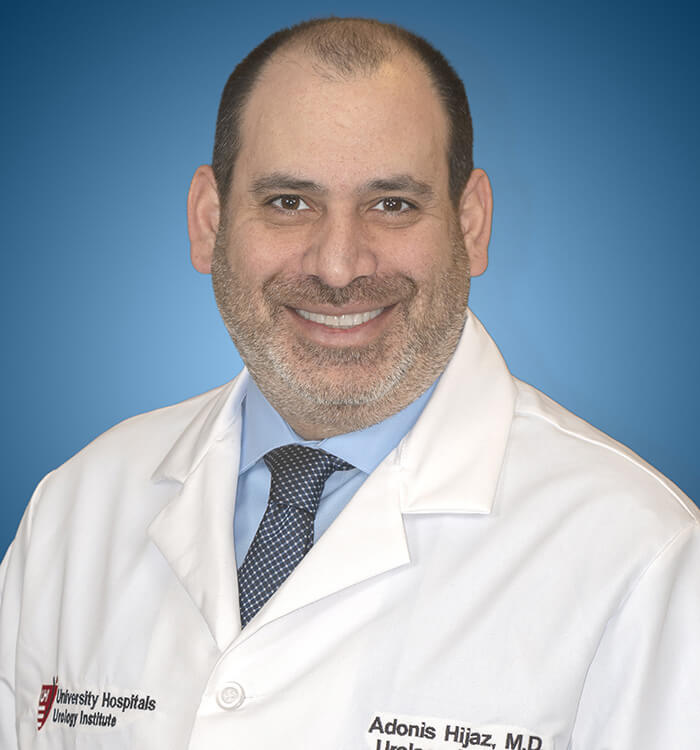New Options Can Improve Quality of Life for Women with Urinary Disorders
January 16, 2022
Women with stress urinary incontinence (SUI) and overactive bladder (OAB) have potential new options
Innovations in Urology | Winter 2022
Improved non-surgical option for SUI
"Although the midurethral sling with mesh is the gold standard for surgical intervention for SUI, not all women want, or are candidates for, surgery", says David Sheyn, MD, a urologist at University Hospitals Urology Institute. "For these women, urethral bulking agents are an alternative, although traditionally they have not been as effective as surgery."
 David Sheyn, MD
David Sheyn, MD Adonis Hijaz, MD
Adonis Hijaz, MD“The old bulking materials were particulates made of tiny spheres,” Dr. Sheyn says. “They worked about 70 percent of the time right off the bat, but after two or three years, the efficacy was only 30 to 40 percent. In some cases, the procedure didn’t work at all.”
However, the U.S. Food & Drug Administration recently approved Bulkamid, a hydrogel bulking agent that is more than 90 percent water, and UH began using it in clinical practice in August 2021. Clinicians now have an alternative tool in their armamentarium that overcomes some of the limitations of other bulking agents, says Adonis Hijaz, MD, Director of Female Pelvic Surgery and Vice Chairman of Department of Urology at University Hospitals Cleveland Medical Center.
“This new therapy is significant,” Dr. Hijaz says. “The delivery mechanism is an injectable delivered through a custom-made scope that has a 90-degree angle for improved visualization in the urethra. It also has a sheath around the scope that allows the operator to deliver the injection precisely at the desired location.”
Bulkamid has a similar rate of success to surgery, Dr. Sheyn says. About 70 percent of patients are 90 percent or better.
“The main difference is at seven to 10 years, this intervention seems to be just as good compared to other bulking agents, and it’s way less invasive than sling surgery,” Dr. Sheyn says. “It can be performed in the office or an operating room, depending on patient comfort levels, and requires almost no recovery. Many patients resume regular activities the following day.”
Although sling surgery is still the mainstay of surgical interventions for SUI, Dr. Hijaz says, physicians should know there are several subpopulations for which Bulkamid might be a good alternative to surgery, and they can refer these patients to UH.
- Younger women in their childbearing years who still want to get pregnant
- Women who are not of childbearing age but still complain of SUI
- Women who have already had sling surgery who experienced some improvement but not complete resolution of symptoms
- Women who have extreme Intrinsic Sphincter Deficiency
Using Artificial intelligence in treating overactive bladder
Overactive bladder is a chronic condition for which roughly 70 percent of cases are idiopathic, Dr. Sheyn says. Furthermore, many patients suffer for up to seven years from onset of symptoms until they start appropriate treatment. Behavior modification and pelvic floor physical therapy are first-line therapies before advancing to bladder training and more invasive treatments.
Renalis, a digital therapeutics company, has developed an Artificial Intelligence-based platform to help patients manage OAB.
“Renalis helps people keep track of pelvic floor therapy and fluid intake and make adjustments as needed,” Dr. Sheyn says. “It includes an educational component and, in some cases, can replace physical therapy. You don’t really realize how OAB can affect your quality of life until it becomes a problem. Renalis helps increase awareness of, and attention to, OAB.”
Dr. Sheyn will conduct a pilot study in 30 to 50 patients who are treatment naive or who have never been treated for OAB by a urogynecologist or a urologist. Participants will download the app and use it in a real-world setting, with the hopes it significantly improves their symptoms.
“If the pilot study is successful, we will submit a grant to the Agency for Healthcare Research Quality to integrate Renalis with primary care practices where most patients first present with complaints about OAB,” he says. “Then we’ll do a large, randomized control trial with 300 patients and compare it to a sham therapeutic. If it’s successful, we can take it commercial.”
Dr. Hijaz says UH is excited about the study and the ability to have a chatbot as a therapeutic option to help patients navigate OAB in a non-intrusive way. Through one-to-one interactions, the chatbot can analyze symptoms and guide patients through therapy.
“Patients are often embarrassed about talking about OAB with their Primary Care Provider,” Dr. Hijaz says, “and PCPs don’t always have the ability to handle OAB on top of managing other chronic diseases. With this technology, patients don’t have to talk to a healthcare provider. This is exciting, and we look forward to seeing the results of Dr. Sheyn’s study.”


